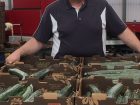
Features
Environmental Control
Structures & Equipment
Using Fog to Improve Growing Conditions
It helps growers market products better able to withstand pest and disease pressures.
May 15, 2015 By Peter Mitham
June 2015 – Greenhouses, with their moist, warm atmospheres, may seem absolutely tropical to many people in late winter, but from the vegetables’ point of view, the proportion of warmth and humidity isn’t always optimal.
Sensitive, fast-growing crops like cucumbers are particularly vulnerable to stress when temperature and humidity are out of balance, which is why Origin Organic Farms Inc. (which sells under the OriginO brand) of Delta, B.C., installed a fogging system in 2014.
“Cucumbers are fast growing and they tended to need that extra help to maintain quality,” said Keith Hammonds, vice-president of operations with OriginO.
A fogging system creates a more suitable environment that reduces stress on the crop in the summer – from June through September – and thereby boosts its health and ability to ward off disease.
“In the summer, we could have the humidity at 40 per cent normally, (but) because we have the fogging system, we keep the humidity about 65 per cent to 70 per cent so it doesn’t stress the crop out so much,” Hammonds said.
OriginO’s tomatoes and peppers don’t require such coddling, but every location is different due to the local climate, orientation of the greenhouse and the crop it grows.
MicroCool of Palm Springs, Calif., advised OriginO on its system, assessing its requirements and helping calibrate the system.
MicroCool vice-president Mark Stanley told growers attending the Pacific Agriculture Show in B.C. this past January that as the temperature and humidity change on an hourly basis, detailed analysis is made before commissioning a system.
“We’ve got to play around with the minimums and the maximums temperature and humidity levels to come to a solution,” Stanley said. “We calculate the amount of [water/humidity] needed for a specific volume of air and adjust the number of nozzles accordingly.”
To do this, Stanley effectively adds moisture to the air that flash evaporates cooling down warm air on hot days.
“As the cooling system comes on, the humidity will rise as the fog flash evaporates and cools. If the air reaches the maximum humidity set point (set by the grower for various crops), it will shut off, then the greenhouse temperature rises (with no cooling) until fresh air lowers the humidity level and the fog system is activated,” Stanley explained. “So the temperature reduction floats around a humidity set point.”
A fogging system places nozzles around a greenhouse to ensure even coverage and distribution; the high-pressure fog at 10 microns is fine and barely noticeable.
Normal filters (5- micron) do not remove the aqueous salts and minerals in the water that could cause blockage of the 0.20 mm nozzle orifice. Sometimes other treatments (i.e., reverse osmosis) must be used for successful operation of the system.
“This principle, it’s the same for a small, 10 metre by 40 metre greenhouse, and it’s the same for a multiple hectare greenhouse,” Stanley told growers.
The linchpin of any fogging system, however, is the control panel. A system designed to maintain even humidity levels has to be able to integrate operations with the rest of the house (ventilators, heating, fans, etc). Since the fog system is oriented around the temperature and humidity set points, a climate controlled fogging system that can’t provide precise control of humidity isn’t doing its job.
“The fog system is only as good as the system that’s controlling it,” Stanley said. “You can have the best system in the world, and you put a 10-cent control with it and it’s going to be absolutely worthless. A good control on a bad system isn’t necessarily going to make it any better, but it can help.”
It can also reduce the value of the investment.
An elegant system that requires fewer nozzles is designed to use less water, but if the climate control system isn’t reading the environment accurately and failing to control humidification appropriately, then the advantages may be moot.
With the second season for OriginO’s system looming, Hammonds was busy this spring with maintenance tasks – ensuring the lines and nozzles are clean and checking the filtration system.
OriginO uses municipal water that is run through three filters to ensure its purity.
While there’s a cost to municipal water, the climate control MicroCool recommends ensures targeted applications that reduce the volume of water by effectively using the system when it is most efficient.
“It does keep the ambient atmosphere, but it allows the crop to grow and not be under stress,” Hammonds says. “When a crop’s strong, you don’t have to put so much water on.”
The difference has paid off in produce that’s been better able to withstand pest and disease pressures and have a longer shelf life at retail and in consumer’s fridges. This reduces losses, as well as waste after the vegetables leave the farm – an important point given Metro Vancouver’s ban on food waste in its landfill system.
“Our fruit quality is consistent all the way through the year,” Hammonds says.
Peter Mitham is a freelance writer in British Columbia.
Print this page

